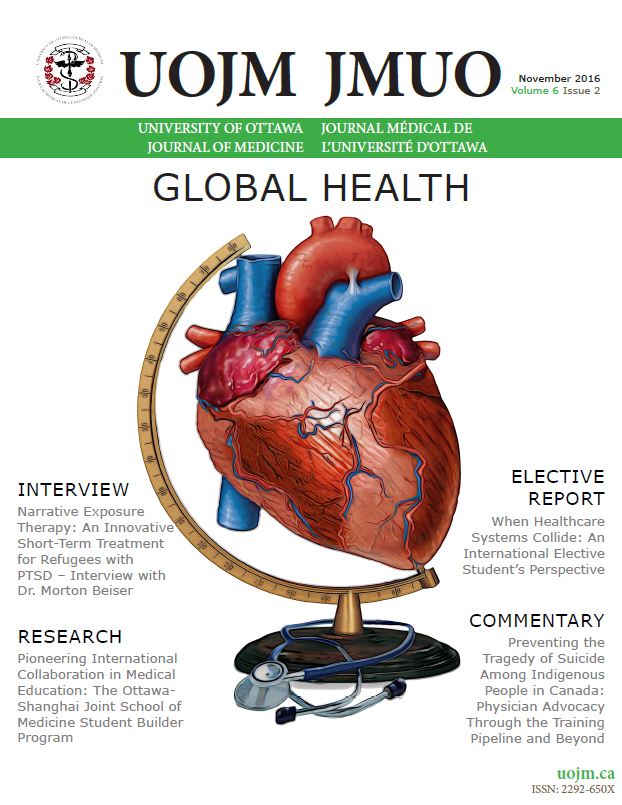The WHO’s Need to Address Insecticide Resistance in Malaria Vectors
DOI:
https://doi.org/10.18192/uojm.v6i2.1510Keywords:
malaria, vector resistance, insecticide resistance, IRS, ITN,Abstract
ABSTRACT
Since 2000, incidence and mortality rates attributable to malaria have declined significantly. However, this decline may be short-lived due to the emergence of insecticide-resistant malaria vectors caused by the overuse of indoor residual spraying (IRS) and insecticide treated nets (ITNs). This policy paper will discuss the emergence, causes, and implications of vector resistance and will propose solutions to prevent a future public health crisis.
RÉSUMÉ
Depuis 2000, l’incidence et les taux de mortalité attribuables au paludisme ont diminué significativement. Toutefois, ce déclin risque d’être de courte durée en raison de l’émergence de vecteurs du paludisme résistants aux insecticides, causée par la surutilisation de la pulvérisation intradomiciliaire (PID) et de moustiquaires imprégnées d’insecticides (MII). Cet article de politique discutera de l’émergence, des causes et des implications de la résistance des vecteurs, et proposera des solutions dans le but de prévenir une éventuelle crise sanitaire.
References
2. World Health Organization. World Malaria Report 2010 [Internet]. Geneva: World Health Organization; 2010 [cited 2016 Feb]. 238 p. Available from: http://www.who.int/malaria/publications/atoz/9789241564106/en/.
3. World Helath Organization. Global Malaria Programme Indoor Re¬sidual Spraying [Internet]. Geneva: World Health Organization; 2006 [cited 2016 Feb]. 16 p. Available from: http://apps.who.int/iris/bit¬stream/10665/69386/1/WHO_HTM_MAL_2006.1112_eng.pdf.
4. World Health Organization. Global Malaria Programme Insecticide-Treat¬ed Mosquito Nets: a WHO Position Statement [Internet]. Geneva: WHO; 2007 [cited 2016 Feb]. 12 p. Available from: http://files.givewell.org/files/ DWDA%202009/Interventions/Nets/itnspospaperfinal.pdf.
5. Yewhalaw D, Wassie F, Steurbaut W, et al. Multiple insecticide resistance: an impediment to insecticide-based malaria vector control program. PLoS One. 2011; 6(1):e16606.
6. African Network for Vector Resistance. Atlas of Insecticide Resistance in Malaria Vectors of the WHO African Region [Internet]. Harare: ANVR; 2005 Oct [cited 2016 Feb]. 27 p. Available from: http://www.afro.who.int/index. php?option=com_docman&task=doc_download&gid=2141.
7. Paeporn P, Supaphathom K, Srisawat R, et al. Biochemical detection of pyre¬throid resistance mechanism in Aedes aegypti in Ratchaburi province, Thai¬land. Trop Biomed. 2004;21(2):145-151.
8. Malaria Consortium. Insecticides Fact Sheet [Internet]. London: Malaria Consortium; 2011 [cited 2016 Feb]. 3 p. Available from http://www.ma-lariaconsortium.org/resources/publications/19/insecticides-fact-sheet.
9. World Health Organization. WHO recommended insecticide products treatment of mosquito nets for malaria vector control [Internet]. Ge¬neva: World Health Organization; 2007 [cited 2016 Feb]. 1 p. Available from: http://www.who.int/whopes/recommendations/en/.
10. Kelly-Hope L, Ranson H, Hemingway J. Lessons from the past: managing insecticide resistance in malaria control and eradication programmes. Lancet Infect Dis. 2008;8(6):387-389.
11. WHO Global Malaria Programme. Global Plan for Insecticide Resistance Management in Malaria Vectors [Internet]. Geneva: World Health Orga¬nization; 2012 [cited 2016 Mar]. 24 p. Available from: http://www.who. int/malaria/vector_control/gpirm_executive_summary_en.pdf?ua=1.
12. World Health Organization. Techniques to detect insecticide resistance mechanisms (field and laboratory manual) [Internet]. Geneva: World Health Organization; 1998 [cited 2016 Feb]. 42 p. Available from: http:// www.who.int/malaria/publications/atoz/who_cds_cpc_mal_98_6/en/.
13. Awolola T, Oduola O, Strode C, et al. Evidence of multiple pyrethroid resistance mechanisms in the malaria vector Anopheles gambiae sensu stricto from Nigeria. Trans R Soc Trop Med Hyg. 2009;103(11):1139-1145.
14. Greenwood BM, Fidock D, Kyle D, et al. Malaria: progress, perils, and prospects for eradication. J Clin Invest. 2008; 118(4):1266-1276.
15. World Health Organization. WHO recommended insecticides for indoor residual spraying against malaria vectors [Internet]. Geneva: World Health Organization; 2013 [cited Feb 2016]. 1 p. Available from: http:// www.who.int/whopes/Insecticides_IRS_Malaria_25_Oct_2013.pdf.
16. Clarke S, Bøgh C, Brown R, et al. Do untreated bednets protect against malaria? Trans R Soc Trop Med Hyg. 2001;95(5):457-462.
17. N’Guessan R, Corbel V, Akogbéto M, et al. Reduced Efficacy of Insecti¬cide-treated Nets and Indoor Residual Spraying for Malaria Control in Py¬rethroid Resistance Area, Benin. Emerg Infect Dis. 2007; 13(2):199-206.
18. Asidi A, N’Guessan R, Koffi A, et al. Experimental hut evaluation of bed¬nets treated with an organophosphate (chlorpyrifos-methyl) or a pyre¬throid (lambdacyhalothrin) alone and in combination against insecticide-resistant Anopheles gambiae and Culex quinquefasciatus mosquitoes. Malar J. 2005. 4:25.
19. World Health Organization: Conditions for use of long-lasting insecti¬cidal nets treated with a pyrethroid and piperonyl butoxide [Internet]. Geneva: World Health Organization; 2015 [cited 2016 Mar]. 2 p. Avail¬able from: http://www.who.int/malaria/publications/atoz/use-of-pbo-treated-llins/en/.
20. Guillet P, N’Guessan R, Darriet F, et al. Combined pyrethroid and car¬bamate ‘two-in-one’ treated mosquito nets: field efficacy against pyre¬throid-resistant Anopheles gambiae and Culex quinquefasciatus. Med Vet Entomol. 2001; 15(1):105-112.
21. Yukich J, Tediosi F, Lengeler C. Comparative cost-effectiveness of ITNs or IRS in Sub-Saharan Africa. Malaria Matters. 2007; 2-4.
22. World Health Organization. Insecticide resistance [Internet]. Geneva: World Health Organization; 2015 [cited 2016 Mar]. Available from: http://www.who.int/malaria/areas/vector_control/insecticide_resis¬tance/en/.
23. The malERA Consultative Group on Monitoring, Evaluation, and Surveil¬lance. A Research Agenda for Malaria Eradication: Monitoring, Evalua¬tion, and Surveillance. PLoS Med. 2011;8(1): e1000400.
Downloads
Published
Issue
Section
License
- Authors publishing in the UOJM retain copyright of their articles, including all the drafts and the final published version in the journal.
- While UOJM does not retain any rights to the articles submitted, by agreeing to publish in UOJM, authors are granting the journal right of first publication and distribution rights of their articles.
- Authors are free to submit their works to other publications, including journals, institutional repositories or books, with an acknowledgment of its initial publication in UOJM.
- Copies of UOJM are distributed both in print and online, and all materials will be publicly available online. The journal holds no legal responsibility as to how these materials will be used by the public.
- Please ensure that all authors, co-authors and investigators have read and agree to these terms.
- Works are licensed under a Creative Commons Attribution-NonCommercial-NoDerivatives 4.0 International License.


